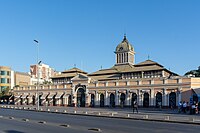List of Pecario National Landmarks: Difference between revisions
Jump to navigation
Jump to search
Mr.Trumpet (talk | contribs) No edit summary |
Mr.Trumpet (talk | contribs) |
||
| Line 8: | Line 8: | ||
|- | |- | ||
| [[Basílica de Nuestra Señora de Copanaca]] || [[Image:Capilla de Indios Santuario de Copacabana Copacabana Bolivia.jpg|200px|center]] || July 12, 1834 || [[Pecario#Administrative divisions|Altamar]] || Tacolic basilica || | | [[Basílica de Nuestra Señora de Copanaca]] || [[Image:Capilla de Indios Santuario de Copacabana Copacabana Bolivia.jpg|200px|center]] || July 12, 1834 || [[Pecario#Administrative divisions|Altamar]] || Tacolic basilica || | ||
|- | |- | ||
| [[La Reina’s Palace]] || [[Image:Royal Palace of Madrid Panorama.jpg|200px|center]] || September 15, 1892 || [[Pecario#Administrative divisions|Fortaleza]] || A former royal residence that now serves as a museum || | | [[La Reina’s Palace]] || [[Image:Royal Palace of Madrid Panorama.jpg|200px|center]] || September 15, 1892 || [[Pecario#Administrative divisions|Fortaleza]] || A former royal residence that now serves as a museum || | ||
| Line 16: | Line 14: | ||
|- | |- | ||
| [[The Grand Bazaar]] || [[Image:Mercado Central, Santiago 20230324.jpg|200px|center]] || March 22, 1954 || [[Pecario#Administrative divisions|Costa del Sol]] || The oldest Pecarian marketplace is a hub for traders and visitors || | | [[The Grand Bazaar]] || [[Image:Mercado Central, Santiago 20230324.jpg|200px|center]] || March 22, 1954 || [[Pecario#Administrative divisions|Costa del Sol]] || The oldest Pecarian marketplace is a hub for traders and visitors || | ||
|- | |||
| [[Basilica of San Luis]] || [[Image:Mañana Cruceña.jpg|200px|center]] || March 15, 1889 || [[Pecario#Administrative divisions|Costa Dorada]] || Tacolic basilica || | |||
|- | |- | ||
| [[San Luis Univeristy]] || [[Image:UNMSM Facultad de Medicina San Fernando.jpg|200px|center]] || July 17, 1923 || [[Pecario#Administrative divisions|Costa Dorada]] || One of the oldest educational institutions in Pecario, renowned for its research in history and cultural studies || | | [[San Luis Univeristy]] || [[Image:UNMSM Facultad de Medicina San Fernando.jpg|200px|center]] || July 17, 1923 || [[Pecario#Administrative divisions|Costa Dorada]] || One of the oldest educational institutions in Pecario, renowned for its research in history and cultural studies || | ||
Revision as of 12:21, 17 June 2024
A National Landmark is a building, object, site, natural feature, or structure that is officially recognized by the Pecarian government for its noteworthy historical, political, cultural, or scientific significance. The National Monuments Center (Stillian : Centro de Monumentos Nacionales) under the Pecarian Ministry of Culture (Stillian : Ministro de la Cultura) is responsible for the classification and maintenance of national landmarks.
List of Landmarks
| Landmark Name | Image | Date Designated | Location | Description | Type |
|---|---|---|---|---|---|
| Basílica de Nuestra Señora de Copanaca | July 12, 1834 | Altamar | Tacolic basilica | ||
| La Reina’s Palace | September 15, 1892 | Fortaleza | A former royal residence that now serves as a museum | ||
| Vineyards of Villa de la Reina | May 25, 1976 | Fortaleza | These vineyards once served to provide grand cru wines to the kings and queens of Pecario. | ||
| The Grand Bazaar | March 22, 1954 | Costa del Sol | The oldest Pecarian marketplace is a hub for traders and visitors | ||
| Basilica of San Luis | March 15, 1889 | Costa Dorada | Tacolic basilica | ||
| San Luis Univeristy | July 17, 1923 | Costa Dorada | One of the oldest educational institutions in Pecario, renowned for its research in history and cultural studies | ||
| The Lysian Quarter | July 7, 1955 | Costa Dorada | This charming district features narrow cobblestone streets, cafes, artisan shops and traditional cuisine celebrating the region’s Lysian heritage. | ||
| Florentian Suburbs | August 15, 1978 | Costa Dorada | Residential areas characterized by modest homes and communal gardens, reflecting the hard-working spirit of Florentia immigrants who settled in Pecario during the early 20th century. |







